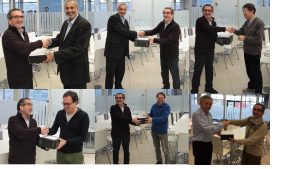The Ship science team will be welcoming visitors this summer and autumn as part of the University of Southampton’s Open Days.

Talks will give opportunities to learn more about the maritime sector and the exciting careers possible with a degree in Ship Science as well as demonstrations in our impressive 138 m long , 6 m wide and 3.5 m long wave and towing tank.
Maritime is a rapidly growing sector where there is significant skills shortage. A recent article by the chair of Maritime UK, Ocean economy offers UK a trillion pound opportunity in undiscovered gold and precious metals highlights what are seen as the many opportunities enabled by the 4th industrial revolution enabled by digital technology. Ship scientists and maritime engineers are at the heart of the application of the new developments in technology ensuring that these can be applied safely and in an environmentally sensitive way.
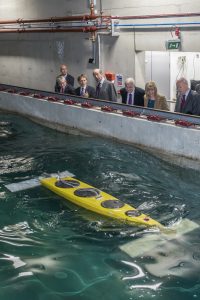
Our staff and students will be on hand to explain and answer any questions you might have.
Tag Archives: naval architecture
World Sailing Robot Championship coming to Southampton
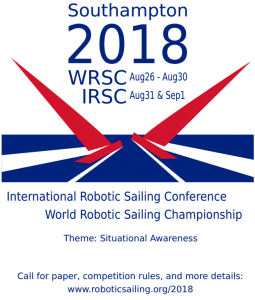 Dr Nick Townsend is the lead academic supporting an enthusiastic team of Doctoral and undergraduate students hostng the World Robot Sailing Chmapionship at the end of August 2018. There are still places for teams to enter so sign up soon!
Dr Nick Townsend is the lead academic supporting an enthusiastic team of Doctoral and undergraduate students hostng the World Robot Sailing Chmapionship at the end of August 2018. There are still places for teams to enter so sign up soon!
Summer Study in Ship Science
We are fortunate to offer three research internships based in the fluid structure interactions group. These are intended primarily for ship science students just finishing their 3rd year and provide an eight week research experience.
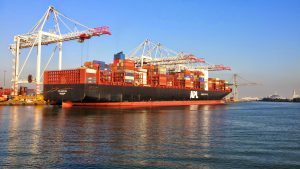
Professor Dominic Hudson is looking for someone to work Prediction of ship power using machine learning
and
Dr Joe Banks has two positions related to his work on the characterisation of the fluid structure interaction of ship propellers
Research Intern into propeller performance –
and as part of the on-going work of teh performance sports engineering lab investigating performance of elite swimmers
Research Intern into Swimming Performance –
If you are interested please contact Dominic or Joe directly.
We also have some PhD opportunities in swimming for students who qualify as suitable for EPSRC.
High performance computing solves Ship Science challenges
The fifth generation of the University of Southampton’s supercomputers Iridis 5 has come on line. It has 20,000-cores and has a peak performance of 1.3 Petaflops. A ‘flop’ is floatng point operations per second such as adding two real numbers in a second and Peta is 1 quadrillion eg 10 to the power 15 .

The 20,000-core machine was designed and built by high performance computing (HPC) integrator OCF using ThinkSystem SD530 servers from Lenovo. It has already emerged as one of the most powerful systems in the world, entering the Top500 supercomputer list in November,at number 251.

One of the key users over many years is our own Wolfson Unit for Marine Technology and Industrial Aerodynamics(WUMTIA) who provide a variety of Computational Fluid Dynamics(CFD) services to industry. Dr Sandy Wright, principal research engineer, Wolfson Unit at the University of Southampton comments in an OCF press release. “We have a worldwide customer base and have worked with the British Cycling Team for the last three Olympic games, as well as working with teams involved in the America’s Cup yacht race. In the past 10 years, Computational Fluid Dynamics (CFD) has become a perfectly valid commercial activity, reducing the need for physical experimentation. CFD gives as good an answer as the wind tunnel, without the need to build models, so you can speed up research whilst reducing costs. Iridis 5 will enable the Wolfson Unit to get more accurate results, whilst looking at more parameters and asking more questions of computational models.”
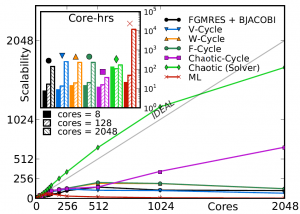
PhD students in FSI are alo important users of the Iridis computers. One example is Dr James Hawkes who recently completed his PhD in collboration with Dr Guilherme Vaz of the Refresco team at MARIN on ‘Chaotic methods for the strong scalability of CFD‘. His work investigated how best to design CFD codes of the future to work across thousands of cores.
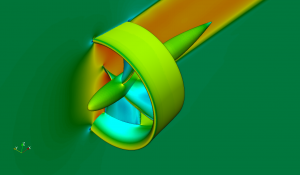
Wind tunnel tests on deep water underwater autonomous glider
As part of the BRIDGES EUH2020 (http://www.bridges-h2020.eu/). research programme the hydrodynamic performance of the external shape was successfully validaterd in the large R.J.Mitchell wind tunnel at the University of Southampton. The glider is designed to carry out long duration autonomous scientific missions down to depths of 3000m. Current underwater gliders are typically limited in depth (~150 m). This is one of the funded projects underway in the maritime robotics laboratory.
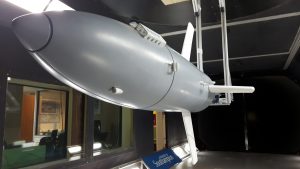
Dr Artur Lidtke , Research Fellow in the Maritime Robotics Lab at the FSI Group, carrie dout the tests over a one week period. Thanks to the size of the facility, hydrodynamic performance of the AUV could be measured at full-scale Reynolds numbers, allowing detailed quantification of drag augments associated with different vehicle configurations. The information will help to validate the design, which has been devised based on fluid dynamic simulations (CFD), allow better estimation of mission endurance, and lead to an improved understanding of performance of such AUVs in the future.
See also: https://twitter.com/BRIDGESh2020/status/956851894449827840
Maritime Robotics in San Diego for Blue Week
Dr Jon Downes attended the Maritime Alliance Bluetech week held in San Diego 6th Nov to 10th Nov as part of the UK Government delegation funded by the Foreign and Commonwealth Office Science and Innovation Network. The UK delegation included a wide range of people from UK Government, Royal Navy, MCA, NOC, UK Universities. British Embassy Washington DC, and members of the British Consulate-General in LA.
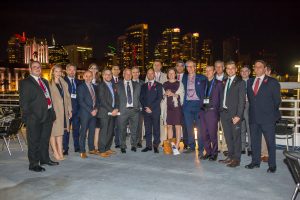
The UK Delegation attending the Maritime Alliance Bluetech Week Dinner
The delegation was visiting San Diego to build UK – US links in the Maritime Autonomous Systems sector as San Diego is home to a number of developing companies and universities. A packed week of meetings and visits ensued – visiting Scripps Institute, SPARWAR, and Coleman University Hornets Nest as part of the week. A key part of the weeks activities was the Marine Autonomous Systems UK-US Collaborative Opportunities workshop with approximately 70 attendees and a report on the discussions is expected to be made available during 2018.
The delegation attended the Maritime Alliance demonstration day witnessing some of the autonomous platforms currently under development in the US. These included the WAM-V unmanned surface vessel cooperating with underwater and aerial platforms.

Thanks to the dedication and hardwork organising this event of David Pasquini, Nick Hooper, Natalie Hatour, and Pauline Wood of the British Consulate-General in LA, this was an excellent opportunity to build links both internationally with the USA and also within the UK Delegation itself. Some final hours were used to visit the aircraft carrier USS Midway.

Summer Schools for Future Maritime Engineers
In July we hosted not one but three residential engineering summer schools, seeing over 160 students visit and stay at the University to learn about Ship Science.
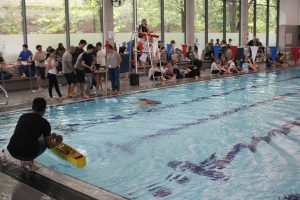
It all started with the newly designed Smallpeice Course thanks to Drs’ Arun, Francesco and Yikun! This course saw Year 9 students design, build and test wave energy converters and supply vessels.
Filming the action at smallpeice trials
This was followed by the Marine Headstart course led by Dr Joe Banks where Year 12 students designed, built and tested tidal turbines – learning all about renewables, ship science and marine engineering.
While last but not least the Design Triathlon Summer School led by Dr Nick Townsend saw Year 12 students design, build, test and race speedboats – learning all about hydrostatics, hydrodynamics and the design process.
Thanks to all those who participated and the staff and phd student who helped out over the week – it was great fun for all.
If you would like to know more about these courses and engineering outreach at the University of Southampton be sure to check out. Similar course will take place next year and are a great opportunity to learn about maritime engineering and ship science and possible careers that follow.
http://www.etrust.org.uk/marine-engineering-and-nautical-science-southampton
https://www.southampton.ac.uk/schools-colleges/design-triathlon.page
https://www.southampton.ac.uk/schools-colleges/marine-headstart.page
Summer Open day opportunities – learn more about ship science, naval architecture and marine engineering
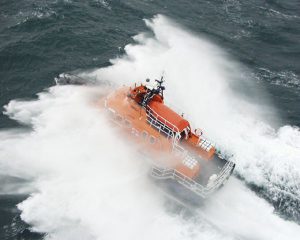
For many the maritime sector is not one they may know much about but there are many exciting careers in the industry, with plenty of opportunities to travel, work abroad and not just to always sit behind a desk at a computer. Our graduates are highly sought after in the industry and can be found in leadership positions worldwide and across a range of sectors from cruise ships, America’s Cup team, offshore industry, ship design and consultancy, marine renewables, defence sector, academia and even Silicon Valley. We are the only degree programme in the UK which is accredited by the Royal Institution of Naval Architects, Institute of Marine Engineering, Science and Technology, and the Institution of Mechanical Engineers. There are exciting engineering challenges in the maritime sector from how do we decarbonise shipping, protect lives at sea, maritime robotics, develop cost effect marine energy harvesters for wind, wave and tide to name but a few.
For those studying hard at school who are interested in the maritime engineering sector we have four open days this summer. Staff and students will be on hand to answer questions and show some of our facilities and educational experience. Our degree course cover a wide range of the maritime sector and provide great flexibility. We look for strong grades in maths and a suitable science such as physics, chemistry or further maths. Our admissions team is always happy to answer question either by email or phone.
This summer’s University open days are taking place on Saturday 8th July, Saturday 9th and Sunday 10th September and Saturday 14th October. To book for the 8th July or register an interest and find out more http://www.southampton.ac.uk/about/visit/open-days.page . It will be great to meet you and explain more.
Part 2 Ship Science Students Tour China's Maritime Sector

For the second year our second year ship science students have been able to visit ship yards and maritime organisations in China on a 10 day whistle stop tour. The opportunity to visit a variety of ship yards building ships, performance yachts, offshore platforms as well as some of the leading maritime universities and research organisations has been made possible because of a number of on-going educational partnerships between the Faculty of Engineering and Environment and our colleagues in China,
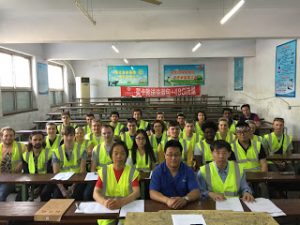
If you want to find out more please find our direct from the student’s blog at csiv2017.blogspot.com. There are some great shout outs to Dr Boyd’s ship production course being seen in action and my personal favourite about the need to reduce the drag of ship rudders..
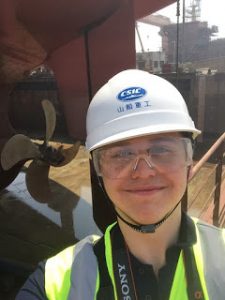
Long service on board ship science…
A recent innovation at the University of Southampton has been the introduction of a recognition award for long service at 20 years (a glass bowl) and 30 years (a carriage clock). Six members of staff in Fluid Structure Interactions were eligible. Presentations were made by our Head of Academic Unit, Prof Penny Temarel. (Top left) to Prof Ajit Shenoi for 30+ years, (Top middle) by Prof Shenoi to Prof Temarel for 20+ years, (Top Right)PT to Dr Mingyi Tan for 20+ years, (Bottom Left) PT to Prof Dominic Hudson for 20+ years, (Bottom Middle) PT to Prof Stephen Turnock for 20+ years and (Bottom Right) PT to Prof Philip Wilson for 30++ years!
